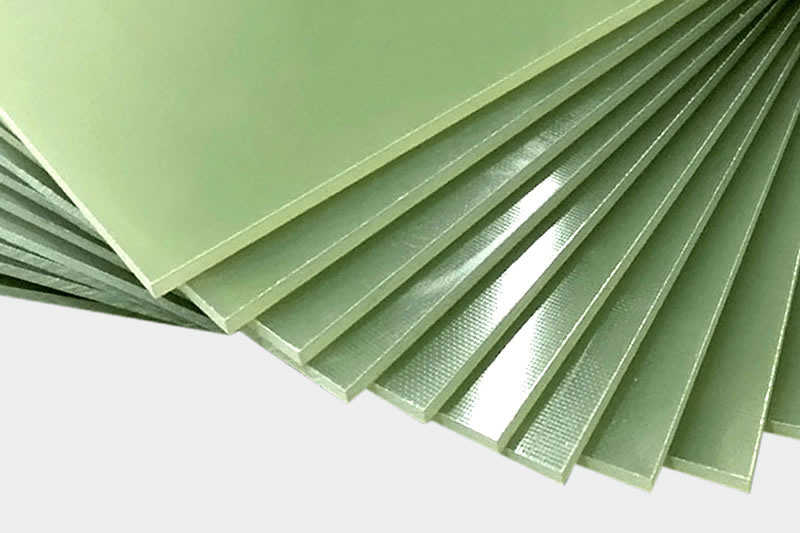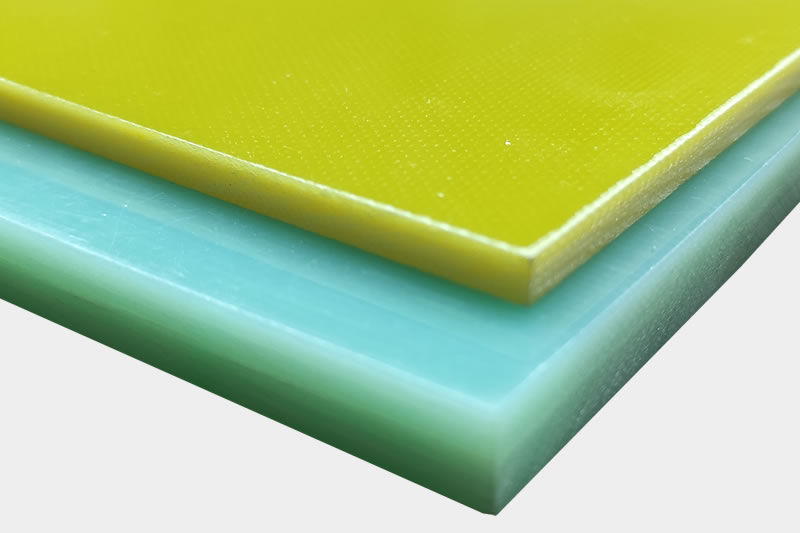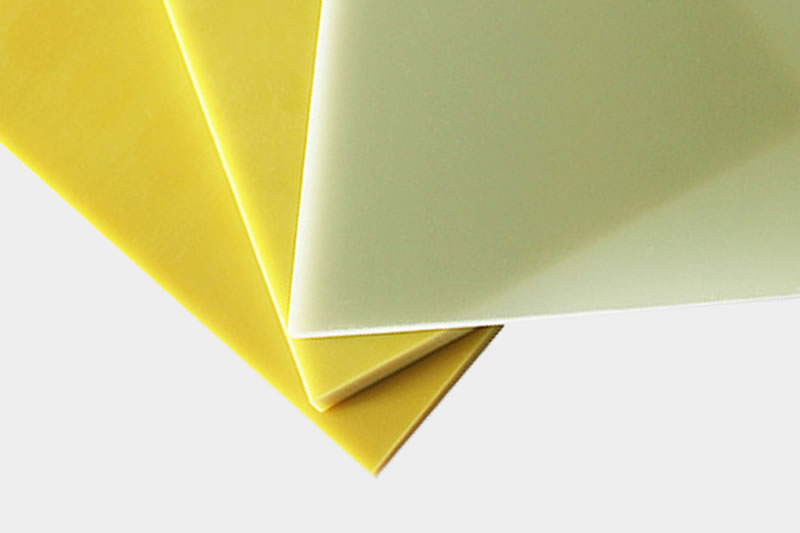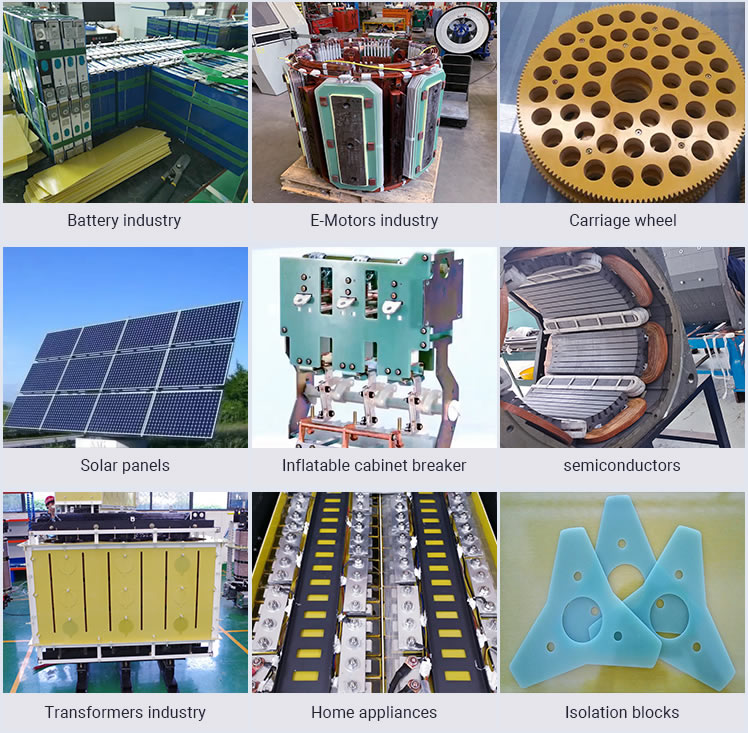Differences Between G11 Epoxy Sheet, G10, and FR4 Comparison Item G10 FR4 G11 Base Material G...
| Comparison Item | G10 | FR4 | G11 |
|---|---|---|---|
| Base Material | Glass fiber cloth + epoxy resin | Glass fiber cloth + epoxy resin (flame-retardant type) | Glass fiber cloth + high heat-resistant epoxy resin |
| Heat Resistance Class | Class B (≈130℃) | Class B (≈130℃) | Class H (≈180℃) |
| Mechanical Strength | High strength, good toughness | Relatively high strength | Similar to G10, but retains strength much better at high temperatures |
| Electrical Properties | Stable insulation in dry and humid conditions | Good insulation, widely used in PCB | Excellent insulation, especially under high temperature and humidity |
| Flame Retardancy | Usually non-flame-retardant | UL94 V-0 flame-retardant | Available in both flame-retardant and non-flame-retardant grades (more flexible than G10) |
| Typical Applications | Motor insulation parts, transformer insulation, mechanical structural parts | Printed circuit boards (PCBs), general electrical insulation components | High-temperature motors, generators, transformers, high-voltage switchgear, heat-resistant structural parts |
| Key Features | High strength but non-flame-retardant | Flame-retardant, suitable for PCB | Upgraded version of G10 with superior heat resistance |
FR4 → Suitable for PCB and general electrical insulation; flame retardancy is the main advantage.

G10 → High strength but non-flame-retardant, commonly used in electrical and mechanical insulation parts.

G11 → An upgraded version of G10 with significantly improved heat resistance (up to 180℃), ideal for high-temperature electrical and mechanical applications.

≥150–180℃ continuous operation or strength required at high temperatures → G11
Up to ~130℃, high strength needed but flame retardancy not required → G10
Flame retardancy (UL94 V-0) or PCB/general insulation required → FR4 (or high Tg FR4)
End rings, spacers, support blocks:
Dry-type, hot spots ≥155℃ → G11 1.0–10 mm (end rings typically 3–6 mm). Excellent dimensional stability at high temperatures.
Oil-immersed, ≤130℃ → G10 1.0–8 mm; use FR4 if flame-retardancy is required.
Creepage / humid environments: G11 or G10 preferred (better insulation stability in moist conditions).
Note: For large parts, chamfer or use rounded corners to reduce stress; degreasing/cleaning is recommended after machining for oil-immersed parts.
F/H-class insulation, frequent thermal shocks → G11 0.8–3 mm (slot wedges usually 1.0–2.0 mm).
Medium temperature (B/F-class) → G10 0.8–3 mm; if flame-retardant required near wiring → FR4.
Highlight: G11 retains mechanical strength much better than G10/FR4 at >150℃, suitable for end supports in high-speed machines.
High cabinet temperature rise, high current density → G11 2–10 mm (busbar supports typically 3–8 mm).
General distribution panels, balancing cost vs flame retardancy → FR4 2–8 mm.
Heavy mechanical loads / tightening torque → G10 or G11; use larger washers or countersunk holes around fasteners.
Circuit boards → FR4 (standard Tg or high Tg 170 grade).
Clamping / structural insulation parts near heat sources → G11 1–4 mm; medium temperature → G10.
Note: If close to heating components and flame-retardancy is required → choose high Tg FR4 or flame-retardant G11.
High cavity temperature, thermal runaway risk → G11 1–3 mm; offers heat resistance and strength.
Normal temperature, lightweight priority → FR4 0.8–2 mm (with flame retardancy); for load-bearing parts → G10 or G11.

| Property | FR4 | G10 | G11 |
|---|---|---|---|
| Continuous Operating Temp. | ~130℃ (higher with high Tg FR4) | ~130℃ | ~155–180℃, more stable |
| Strength Retention at High Temp. | Medium | Medium–High | High |
| Flame Retardancy | UL94 V-0 standard | Usually non-flame-retardant | Flame-retardant or non-FR options available |
| Moisture/Heat Stability | Good | Good | Excellent |
| Machinability | Easy | Easy | Slightly harder, requires good tools |
| Cost (relative) | Low–Medium | Medium | Medium–High |
0.8–1.5 mm → Barriers, shields, slot wedges (G11/G10/FR4 depending on conditions).
2–4 mm → End rings, supports, busbar spacers (medium mechanical load).
5–10 mm → Heavy load supports, base insulation pads (prefer G10 or G11).
Fastener zones → Hole ≥ 1.2 × thickness; edge distance ≥ 2 × thickness; chamfer 0.3–0.5 mm.
Thermal environment: For >150℃ continuous operation, G11 is the safe choice; FR4 weakens more under high heat/humidity.
Flame retardancy compliance: For cabinets, vehicles, energy storage → select V-0 grade (FR4 or flame-retardant G11).
Electrical creepage / clearance: In HV systems, choose G11/G10, increase thickness in humid areas, add ventilation slots.
Machining: Use carbide tools, apply multiple light passes; round corners and chamfer edges.
Surface treatment: For bonding/potting, first sand → clean → degrease (IPA/acetone).
If you are interested in our products,, please send us a message and we will contact you as soon as we receive it. Email: info@ztaero.com whatsApp: +8616650273778